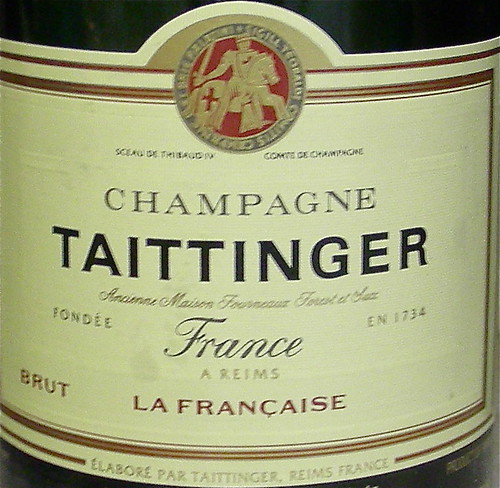 One of them was a bottle of Champagne Taittinger Brut La Française. Founded in 1734 by Pierre Taittinger, the Taittinger Champagne house owns approximately 752 acres of vines, including vineyards in the renowned Côte des Blancs and Montagne de Reims. It is one of the three most extensive wine estates in Champagne and relies primarily on its own grapes for its Champagne production. Pierre Taittinger was a visionary well ahead of his time. He foresaw that the market would turn away from heavily dosed, sweet champagnes in favor of natural, elegant wines and thus defined the Taitinger style to be centered on the concepts of lightness and naturalness.
One of them was a bottle of Champagne Taittinger Brut La Française. Founded in 1734 by Pierre Taittinger, the Taittinger Champagne house owns approximately 752 acres of vines, including vineyards in the renowned Côte des Blancs and Montagne de Reims. It is one of the three most extensive wine estates in Champagne and relies primarily on its own grapes for its Champagne production. Pierre Taittinger was a visionary well ahead of his time. He foresaw that the market would turn away from heavily dosed, sweet champagnes in favor of natural, elegant wines and thus defined the Taitinger style to be centered on the concepts of lightness and naturalness.The cuvée La Française contains approximatively 40% Chardonnay, over twice the percentage of Chardonnay used in the standard cuvées of most Champagne houses, the rest being Pinot Noir and Pinot Meunier. Chardonnay contributes elegance, finesse, and crispness to the blend. Pinot Noir brings body, structure, and vinosity while Pinot Meunier adds fruitiness and roundness. The wine showed a bright golden color and fine bubbles rising from the bottom of the glass. On the palate, it was fresh and lively with toasty, yeasty aromas and notes of apple compote on the finish.
 The other sparkling wine was a bottle of Poema Cava Brut. Cava is a Spanish wine produced mainly in the Penedès region in Catalonia, southwest of Barcelona. Under Spanish D.O. laws, Cava must be made using the Traditional Method with second fermentation in the bottle, and using a selection of grapes that includes Macabeo, Parellada, Xarel·lo, Chardonnay, Pinot noir, and Subirat.
The other sparkling wine was a bottle of Poema Cava Brut. Cava is a Spanish wine produced mainly in the Penedès region in Catalonia, southwest of Barcelona. Under Spanish D.O. laws, Cava must be made using the Traditional Method with second fermentation in the bottle, and using a selection of grapes that includes Macabeo, Parellada, Xarel·lo, Chardonnay, Pinot noir, and Subirat.The Poema Cava Brut is a traditional blend of 40% Macabeo,40% Xarel-lo and 20% Parellada grapes grown in the Penedès region. Each grape variety is harvested separately. Primary fermentation takes place in stainless steel tanks at 16-18ºC. The three varietals are then blended, the triage (yeast and sugar) is added and secondary fermentation begins in the same bottle at a temperature of 13-15ºC.
Low in alcohol (11.5%), the wine had a pale yellow color, aromas of peach and apricots and was light and crisp on the palate. My friends preferred the toasty, yeasty flavors of the Champagne but my father-in-low, who enjoys going to Spain on vacation, really liked the fruity character of the Cava.
Technorati tags: wine food & drink
3 comments:
Happy New Year to you
and don't forget to have a cup of champagne to start 2010
Catherine,
In one month we will be launching wineclubzone.com. We will be launching a blog network and featuring top quality blogs like yours. Our main goal is to index all the wine clubs nationwide both online and offline, and let the bloggers discuss them on our forum.
We wanted to see if you would be interested in joining the network. Here would be the benefits:
1) We would use your site feed and feed in the first 200 characters of your post and link back to you as a means of driving traffic to your site.
2) We will link you from our main blog page.
In return we will ask for a 125X125 widget on the sidebar of your blog.
Let us know if this is something you would be interested in.
Thanks,
Brandon Schrey
Founder
brandon@wineclubzone.com
www.wineclubzone.com
Happy New Year 2010 to you! FYI, I like the link on your e-mail subscription is broken; at least that is what the error message said. Happy Sipping!
Dezel
Post a Comment